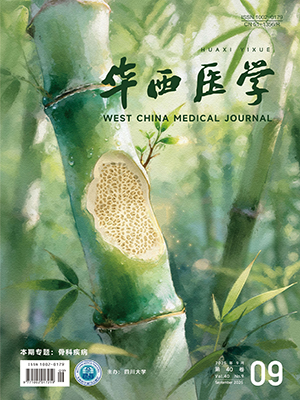| 1. |
Li F, Cui Y, Li Y, et al. Prevalence of mental disorders in school children and adolescents in China: diagnostic data from detailed clinical assessments of 17, 524 individuals. J Child Psychol Psychiatry, 2022, 63(1): 34-46.
|
| 2. |
尚煜, 李进华, 闫承生, 等. 不同亚型注意缺陷多动障碍儿童行为问题的研究. 中国妇幼保健, 2006, 21(13): 1812-1813.
|
| 3. |
Le Bihan D. Looking into the functional architecture of the brain with diffusion MRI. Nat Rev Neurosci, 2003, 4(6): 469-480.
|
| 4. |
Chen L, Hu X, Ouyang L, et al. A systematic review and meta-analysis of tract-based spatial statistics studies regarding attention-deficit/hyperactivity disorder. Neurosci Biobehav Rev, 2016, 68: 838-847.
|
| 5. |
van Ewijk H, Heslenfeld DJ, Zwiers MP, et al. Diffusion tensor imaging in attention deficit/hyperactivity disorder: a systematic review and meta-analysis. Neurosci Biobehav Rev, 2012, 36(4): 1093-1106.
|
| 6. |
American Psychiatric Association. Diagnostic and statistical manual of mental disorders (DSM-IV-TR). United States: American Psychiatric Association, 2000.
|
| 7. |
龚耀先, 蔡太生. 中国修订韦氏儿童智力量表手册. 长沙: 湖南地图出版社, 1993.
|
| 8. |
Conners CK, Sitarenios G, Parker JD, et al. The revised Conners’ Parent Rating Scale (CPRS-R): factor structure, reliability, and criterion validity. J Abnorm Child Psychol, 1998, 26(4): 257-268.
|
| 9. |
Golden CL. Identification of brain disorders by the Stroop Color and Word Test. J Clin Psychol, 1976, 32(3): 654-658.
|
| 10. |
Nelson HE. A modified card sorting test sensitive to frontal lobe defects. Cortex, 1976, 12(4): 313-324.
|
| 11. |
Cortes C, Vapnik V. Support-vector networks. Mach Learn, 1995, 20(3): 273-297.
|
| 12. |
Budak H, Erpolat Taşabat S. A modified t-score for feature selection. Anadolu Univ J Sci Tech A - Appl Sci Eng, 2016, 17(5): 845-845.
|
| 13. |
Beaulieu C. The basis of anisotropic water diffusion in the nervous system - a technical review. NMR Biomed, 2002, 15(7-8): 435-455.
|
| 14. |
Radua J, Grau M, van den Heuvel OA, et al. Multimodal voxel-based meta-analysis of white matter abnormalities in obsessive-compulsive disorder. Neuropsychopharmacology, 2014, 39(7): 1547-1557.
|
| 15. |
Catani M, Thiebaut de Schotten M. A diffusion tensor imaging tractography atlas for virtual in vivo dissections. Cortex, 2008, 44(8): 1105-1132.
|
| 16. |
Aoki Y, Cortese S, Castellanos FX. Research Review: Diffusion tensor imaging studies of attention-deficit/hyperactivity disorder: meta-analyses and reflections on head motion. J Child Psychol Psychiatry, 2018, 59(3): 193-202.
|
| 17. |
Svatkova A, Nestrasil I, Rudser K, et al. Unique white matter microstructural patterns in ADHD presentations-a diffusion tensor imaging study. Hum Brain Mapp, 2016, 37(9): 3323-3336.
|
| 18. |
Pironti VA, Lai MC, Müller U, et al. Neuroanatomical abnormalities and cognitive impairments are shared by adults with attention-deficit/hyperactivity disorder and their unaffected first-degree relatives. Biol Psychiatry, 2014, 76(8): 639-647.
|
| 19. |
Bellis TJ, Billiet C, Ross J. Hemispheric lateralization of bilaterally presented homologous visual and auditory stimuli in normal adults, normal children, and children with central auditory dysfunction. Brain Cogn, 2008, 66(3): 280-289.
|
| 20. |
Gazzaniga MS. Cerebral specialization and interhemispheric communication: does the corpus callosum enable the human condition?. Brain, 2000, 123 ( Pt 7): 1293-1326.
|
| 21. |
Goulardins JB, Marques JC, De Oliveira JA. Attention deficit hyperactivity disorder and motor impairment. Percept Mot Skills, 2017, 124(2): 425-440.
|
| 22. |
Mostofsky SH, Rimrodt SL, Schafer JG, et al. Atypical motor and sensory cortex activation in attention-deficit/hyperactivity disorder: a functional magnetic resonance imaging study of simple sequential finger tapping. Biol Psychiatry, 2006, 59(1): 48-56.
|
| 23. |
McLeod KR, Langevin LM, Dewey D, et al. Atypical within- and between-hemisphere motor network functional connections in children with developmental coordination disorder and attention-deficit/hyperactivity disorder. Neuroimage Clin, 2016, 12: 157-164.
|
| 24. |
Damatac CG, Chauvin RJM, Zwiers MP, et al. White matter microstructure in attention-deficit/hyperactivity disorder: a systematic tractography study in 654 individuals. Biol Psychiatry Cogn Neurosci Neuroimaging, 2022, 7(10): 979-988.
|
| 25. |
Cortese S, Kelly C, Chabernaud C, et al. Toward systems neuroscience of ADHD: a meta-analysis of 55 fMRI studies. Am J Psychiatry, 2012, 169(10): 1038-1055.
|
| 26. |
Lei D, Ma J, Du X, et al. Microstructural abnormalities in the combined and inattentive subtypes of attention deficit hyperactivity disorder: a diffusion tensor imaging study. Sci Rep, 2014, 4: 6875.
|
| 27. |
Ercan ES, Suren S, Bacanlı A, et al. Altered structural connectivity is related to attention deficit/hyperactivity subtypes: a DTI study. Psychiatry Res Neuroimaging, 2016, 256: 57-64.
|
| 28. |
Hong SB, Zalesky A, Fornito A, et al. Connectomic disturbances in attention-deficit/hyperactivity disorder: a whole-brain tractography analysis. Biol Psychiatry, 2014, 76(8): 656-663.
|
| 29. |
Saad JF, Griffiths KR, Korgaonkar MS. A systematic review of imaging studies in the combined and inattentive subtypes of attention deficit hyperactivity disorder. Front Integr Neurosci, 2020, 14: 31.
|




